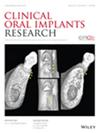Evaluation of Exomass‐Related Artefacts Caused by Dental Implants of Different Materials in Cone‐Beam Computed Tomography Scans: An Ex Vivo Study
IF 4.8
1区 医学
Q1 DENTISTRY, ORAL SURGERY & MEDICINE
引用次数: 0
Abstract
ObjectivesTo evaluate the influence of different dental implant materials within the exomass on the image quality in cone‐beam computed tomography (CBCT).Material and MethodsFive pig jaws were scanned using four CBCT devices, first without any dental implants, followed by scans with three dental implants of the same material—pure titanium, titanium‐zirconium alloy, and zirconium dioxide. Two fields of view (FOVs) were used for each device to position the implants in the exomass of a small FOV and within a large FOV. Voxel values were obtained from tubes containing a radiopaque solution to calculate mean voxel value (MVV), voxel value inhomogeneity (VVI), and image noise (IN), which were compared across implant materials and FOVs using repeated measures analysis of variance (在锥形束计算机断层扫描中评估不同材料牙种植体引起的外质量相关伪影:一项离体研究
目的探讨不同种植体材料对锥形束ct (CBCT)成像质量的影响。材料和方法使用四种CBCT设备扫描5只猪颌,首先不使用任何种植体,然后使用三种相同材料的种植体(纯钛、钛锆合金和二氧化锆)进行扫描。每个装置使用两个视场(FOV)来定位植入物在小视场外和大视场内的位置。体素值从含有不透射线溶液的试管中获得,以计算平均体素值(MVV)、体素值不均匀性(VVI)和图像噪声(IN),并使用重复测量方差分析比较不同种植体材料和fov的体素值(α = 0.05)。三位观察员使用5分制对图像质量进行独立评分。结果总的来说,MVV没有受到影响,除了X800装置中钛或钛锆合金植入物处于小视场外时MVV显著增加(p≤0.05)。当植入物处于小视场外质量时,观察到VVI增加的趋势,其中二氧化锆的影响更大,其次是钛-锆合金和钛。种植体在体外时IN较高,尤其是二氧化锆种植体(p≤0.05)。图像质量感知总体上是一致的,尽管在两个fov中二氧化锆植入导致图像质量下降。结论植入物的存在会对CBCT图像质量产生负面影响,其中二氧化锆的影响最大。
本文章由计算机程序翻译,如有差异,请以英文原文为准。
求助全文
约1分钟内获得全文
求助全文
来源期刊

Clinical Oral Implants Research
医学-工程:生物医学
CiteScore
7.70
自引率
11.60%
发文量
149
审稿时长
3 months
期刊介绍:
Clinical Oral Implants Research conveys scientific progress in the field of implant dentistry and its related areas to clinicians, teachers and researchers concerned with the application of this information for the benefit of patients in need of oral implants. The journal addresses itself to clinicians, general practitioners, periodontists, oral and maxillofacial surgeons and prosthodontists, as well as to teachers, academicians and scholars involved in the education of professionals and in the scientific promotion of the field of implant dentistry.
 求助内容:
求助内容: 应助结果提醒方式:
应助结果提醒方式:


